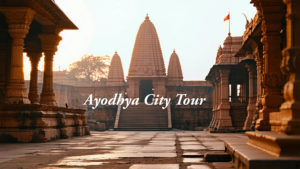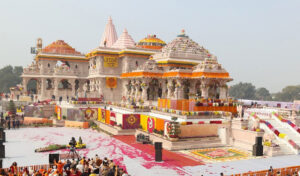Dashrath Mahal, Ayodhya – The Royal Residence of Lord Rama

Among the many Ayodhya sightseeing places, few evoke royal grandeur and mythology as vividly as Dashrath Mahal. Believed to be the residence of King Dashrath, father of Lord Rama, this palace-temple is steeped in epic legends of the Ramayana. Its elegant courtyards, intricate carvings, and devotional ambience make it one of the most captivating Ayodhya tourist attractions. Pilgrims and travellers alike flock here to experience where Lord Rama is said to have spent his childhood.
Where Is Dashrath Mahal? (with GPS Coordinates)
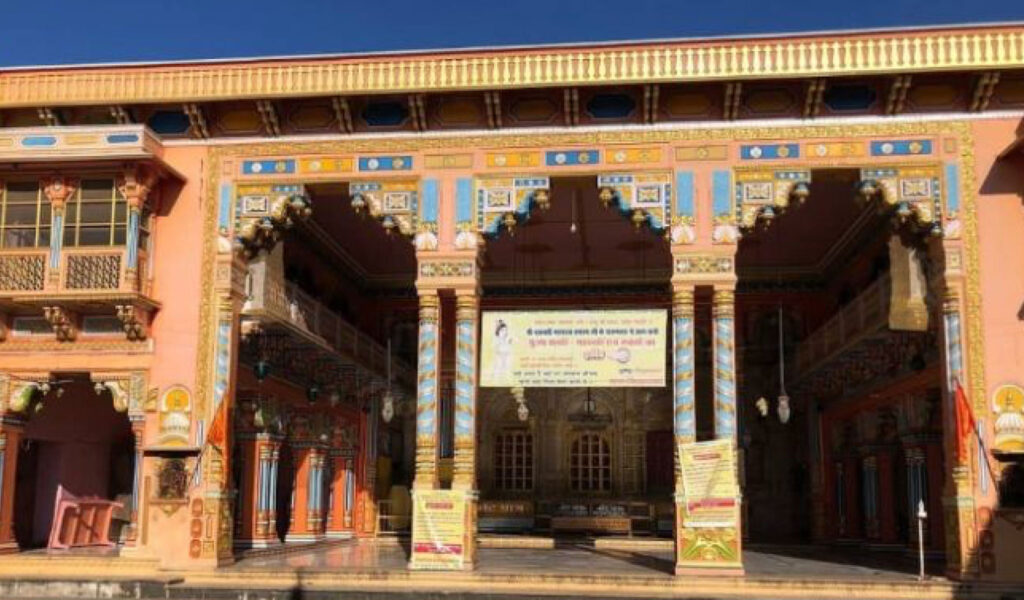
The Dashrath Mahal is located in Ramkot, the historic and spiritual heart of Ayodhya city, Uttar Pradesh. This prime location places it right in the midst of Ayodhya’s most sacred landmarks, making it one of the easiest Ayodhya places to see during a day of temple-hopping.
•Latitude: 26.7969° N
•Longitude: 82.1959° E
These GPS coordinates can be entered into Google Maps for precise directions.
From Ayodhya Junction Railway Station, Dashrath Mahal is only about 1.5 km away, which makes it easily accessible by rickshaw, auto-rickshaw, or even a pleasant walk through the bustling lanes of Ramkot. For air travellers, the newly developed Bhagwan Valmiki International Airport lies around 12 km from the site, ensuring that the palace is well within reach.
Because Dashrath Mahal stands in Ramkot’s central temple circuit, it is often included in itineraries that begin with Sri Ram Janmbhoomi Mandir and then proceed to Kanak Bhawan before reaching Dashrath Mahal. Its location makes it a natural pause between major shrines and a convenient tourist spot in Ayodhya for both pilgrims and casual travellers.
What makes the experience even more special is that Dashrath Mahal is set within narrow, lively lanes lined with shops selling puja items, sweets, souvenirs, and Ramayana-inspired artefacts—adding a cultural flavour to the spiritual journey.
Mythological & Historical Significance of Dashrath Mahal
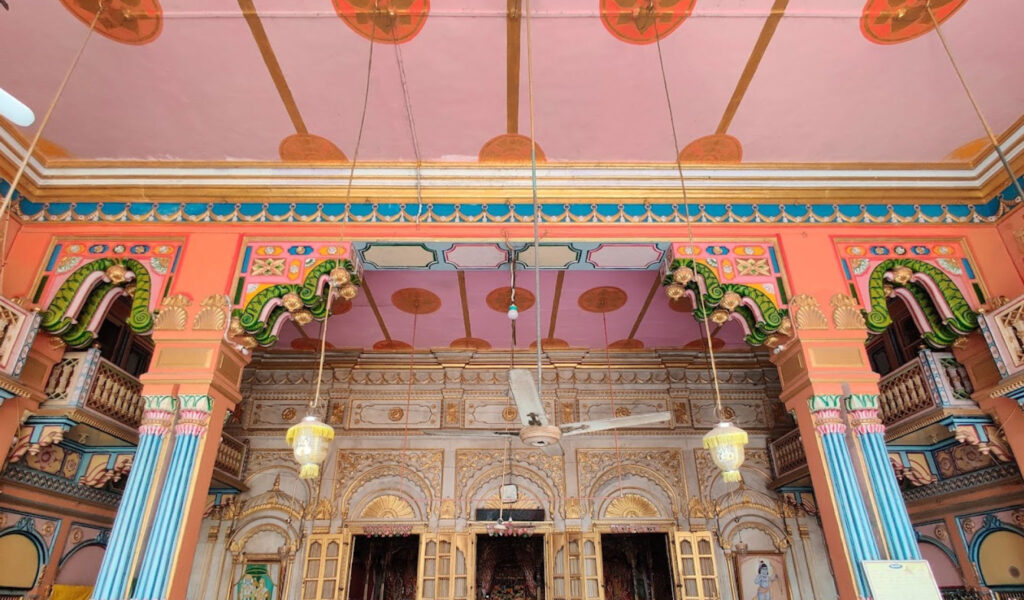
The Dashrath Mahal holds immense importance in the spiritual and cultural heritage of Ayodhya, making it a highlight among Ayodhya tourist attractions. Its very identity is tied to the Ramayana, India’s timeless epic, and to the royal lineage of the Ikshvaku dynasty.
1. Royal Residence
Tradition regards this palace as the residence of King Dashrath, father of Lord Rama. It is here that the four princes—Rama, Lakshmana, Bharata, and Shatrughna—are said to have spent their childhood. The palace, therefore, is not just a monument but a living memory of Rama’s early years in Ayodhya. For pilgrims, visiting Dashrath Mahal creates a tangible connection to the upbringing of the very hero of the Ramayana.
2. Ramayana Legends
Several key episodes from the epic are believed to have taken place within these palace walls. Most notably, the chamber of Queen Kaikeyi is associated with the fateful moment when she demanded that Rama be sent into exile and Bharata be crowned king. This decision, born in the palace, changed the destiny of Ayodhya and set in motion the events of the Ramayana. Later, the palace also witnessed the grief of Bharata upon his return, when he learned of his father’s death and Rama’s departure. These stories make Dashrath Mahal a site steeped in both grandeur and pathos.
3. Spiritual Legacy
Over centuries, the palace has been revered not merely as a royal residence but as a sacred space where dharma (righteousness) was tested and upheld. Saints, devotees, and travellers have regarded Dashrath Mahal as a living reminder of the values of sacrifice, duty, and love that lie at the heart of the Ramayana. With time, the palace was adapted into a devotional site, ensuring its place as a key Ayodhya place to visit for those wishing to immerse themselves in the city’s spiritual heritage.
Dashrath Mahal is more than an architectural landmark—it is a storytelling space, where every arch and courtyard whispers tales from the Ramayana, making it a vital stop for anyone exploring Ayodhya sightseeing places.
Architecture of Dashrath Mahal

The architecture of Dashrath Mahal beautifully combines the grandeur of a royal residence with the sanctity of a temple, giving it a distinct place among Ayodhya tourist attractions. Every element of its design reflects both the palace lifestyle of the Ikshvaku dynasty and the devotional atmosphere that developed here over centuries.
1. Facade & Gateways
The entrance to Dashrath Mahal is strikingly majestic. Visitors are greeted by ornate archways, brightly coloured glass windows, and intricately carved wooden doors. These features echo the opulence of Awadhi palaces, immediately creating a sense of stepping into a royal court. The vibrant colours and decorative motifs also prepare visitors for the festive and spiritual energy that awaits inside.
2. Courtyards
At the heart of the palace lie large open courtyards, surrounded by pillared verandas and airy passageways. These courtyards act as central gathering areas for devotees, particularly during grand festivals like Ram Navami and Diwali, when bhajans, aartis, and cultural performances take place. The expansive design not only accommodates crowds but also fosters a sense of community and celebration.
3. Sanctum
The sanctum sanctorum (garbhagriha) is the spiritual nucleus of Dashrath Mahal. Here, visitors can behold the richly adorned idols of Lord Rama, Sita, Lakshmana, Bharata, and Shatrughna. Each idol is dressed in ornate garments, jewellery, and garlands of flowers, symbolising the divine royalty of the Ayodhya princes. The sanctum itself radiates serenity, where worshippers bow in reverence, experiencing the palace as both home and temple of Lord Rama.
4. Artistic Details
Inside, the palace interiors are a feast for the eyes. Brightly painted murals, delicate arches, and fine latticework (jali designs) showcase the elegance of traditional Awadhi artistry. The walls often depict motifs from the Ramayana, enhancing the storytelling quality of the space. Together, these artistic touches transform Dashrath Mahal into more than an architectural landmark—it becomes an immersive experience, allowing visitors to feel as though they are walking through a living royal residence preserved through time.
With its majestic gateways, expansive courtyards, devotional sanctum, and vibrant artistry, Dashrath Mahal is not just another tourist spot in Ayodhya but a palatial shrine that captures the essence of both royalty and spirituality.
What You’ll See & Do at Dashrath Mahal
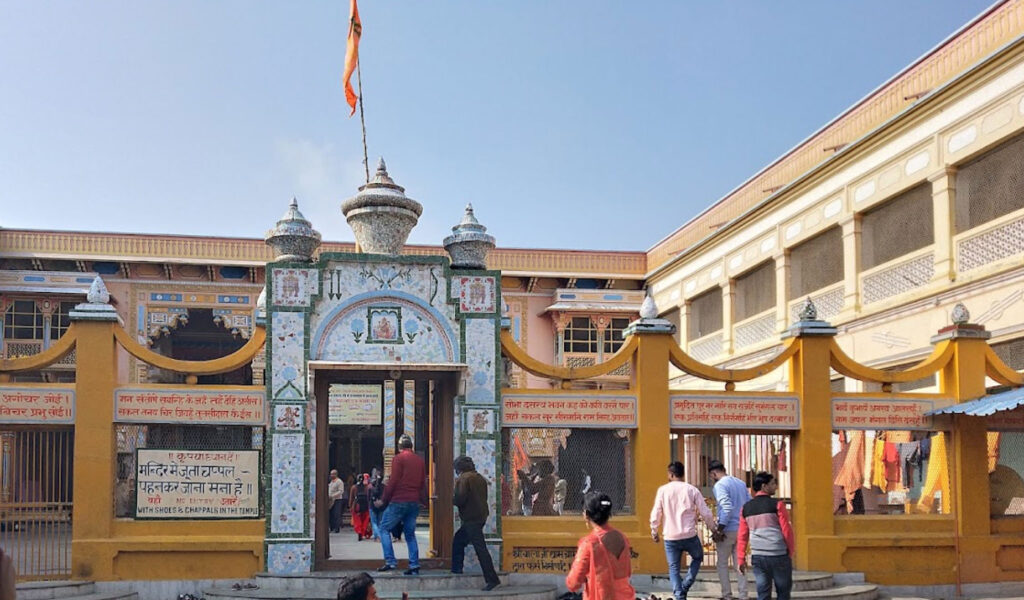
Visiting Dashrath Mahal is both a cultural and devotional experience:
1.Darshan of Rama’s Idols: The sanctum holds exquisitely decorated idols of Lord Rama with his consort and brothers. The daily rituals and aartis create a divine atmosphere.
2.Explore Courtyards & Halls: The spacious courtyards and halls invite you to walk, reflect, and admire the architecture.
3.Festivals: During Ram Navami and Diwali, the Mahal is decorated with lights, garlands, and flags. Cultural performances and bhajans echo through the palace.
4.Local Priests’ Narrations: Listen to priests narrating Ramayana episodes linked to the Mahal, enhancing the spiritual connection.
5.Photography: The ornate facade and colourful interiors are popular for photography, capturing both heritage and devotion.
How to Reach Dashrath Mahal
• By Train: From Ayodhya Junction, Dashrath Mahal is about 1.5 km. Autos and rickshaws are easily available.
•By Road: Ayodhya is connected by road to Lucknow (≈135 km), Varanasi (≈200 km), and Prayagraj. Buses and taxis frequently operate.
•By Air: The nearest airport is Bhagwan Valmiki International Airport, Ayodhya (≈12 km). Lucknow airport is another option.
•Local Transport: Within Ayodhya, rickshaws, e-rickshaws, and walking tours make the palace easy to reach from other Ayodhya tourist attractions.
Combine your visit to Dashrath Mahal with these nearby Ayodhya places to see:
•Sri Ram Janmbhoomi Mandir – birthplace of Lord Rama, Ayodhya’s spiritual centre.
•Kanak Bhawan – Sita’s golden palace, within walking distance.
•Hanuman Garhi – hilltop shrine of Hanuman, protector of Ayodhya.
•Ram Ki Paidi & Saryu Ghats – riverside ghats for evening aarti.
•Nageshwarnath Temple – linked to Kush, son of Lord Rama.
Best Time to Visit & Travel Tips
•Season: October to March is the most comfortable period. Summers can be very hot, and monsoons may make roads slippery.
•Best Time of Day: Early mornings or evenings provide a peaceful darshan. Evenings are particularly beautiful when the palace is lit up.
•Festivals: Visit during Ram Navami for grand celebrations, though expect large crowds.
•Travel Tips: Dress modestly, carry water, and remove footwear before entering sanctum areas. Photography is usually allowed in outer courtyards.
Suggested Itinerary
•Morning: Start with darshan at Sri Ram Janmbhoomi Mandir, then walk to Kanak Bhawan.
•Midday: Visit Dashrath Mahal, exploring its courtyards and idols.
•Afternoon: Take lunch at a local eatery; then head to Hanuman Garhi for panoramic city views.
•Evening: Relax at the Saryu River ghats; join the evening aarti at Ram Ki Paidi.
FAQs – Dashrath Mahal, Ayodhya
1.What is Dashrath Mahal?
Dashrath Mahal is a historical palace in Ayodhya believed to have been the residence of King Dashrath, father of Lord Rama. The Mahal today functions as a devotional site, preserving its mythological and royal heritage.
2.Where is Dashrath Mahal located exactly?
It is situated in Ramkot, in central Ayodhya city, Uttar Pradesh. (Close to Ram Janmabhoomi and Kanak Bhawan).
3.What are the timings for Dashrath Mahal?
The palace is open in two main slots: morning 8:00 AM to 12:00 PM, and evening 4:00 PM to 10:00 PM. Visiting during these hours is best to experience both serenity and ritual atmosphere.
4.Is there an entry fee for Dashrath Mahal?
No. Entry to Dashrath Mahal is free for visitors. There may be donation boxes for those wishing to contribute.
5.How much time should one allot for a visit?
Most travel guides recommend about 1 hour to explore the palace premises, get darshan, enjoy its architecture, and soak in the environment. If doing photography or festival events, more time might be needed.
6.What can I expect to see at Dashrath Mahal?
You’ll see a shrine with idols of Lord Rama, Sita, Lakshmana (and sometimes Bharata & Shatrughna), courtyards, decorated façades, devotees reciting scriptures, and vibrant decor during festivals.
7.What are the best times/festivals to visit?
Besides early morning or evenings for calm visitation, Ram Navami, Shravan, Diwali, and other Ramayana-related festivals are especially vibrant here—expect special decorations and devotional programmes.
8.Are there any restrictions (dress code, photography, etc.)?
Travel-guide sources suggest modest dress is expected. Photography is generally allowed in courtyards and outer areas; inside sanctum or during rituals there may be restrictions. Always good to check locally. (No official source clearly states absolute policies).
9.What is the condition / state of preservation?
Dashrath Mahal has been renovated over time and maintained by local authorities. It is in active use as a devotional space. Some parts reflect restoration efforts.
10.Are there facilities (food, shops, rest) near Dashrath Mahal?
Yes. There are small shops and stalls nearby for items like puja materials, souvenirs. Local eateries are available. Because it’s centrally located, basic amenities are accessible.
Conclusion
Dashrath Mahal is more than just another tourist spot in Ayodhya—it is a palace where mythology, history, and devotion come alive. With its ornate architecture, legendary associations with Lord Rama’s childhood, and vibrant festivals, it offers visitors a rare glimpse into Ayodhya’s royal and spiritual past. If you’re planning a trip, be sure to include Dashrath Mahal in your list of Ayodhya tourist attractions for a truly enriching experience.

